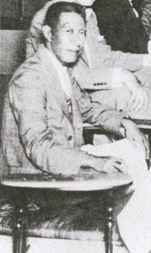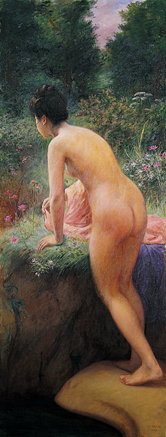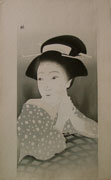Prints in Collection
Biographical Data
Biography
Okada Saburōsuke 岡田三郎助 (1869-1939)
Sources: Marubeni Corporation website http://www.marubeni.com/gallery/painting_j/paint_06.html; Mie Prefectural Art Museum http://www.pref.mie.jp/bijutsu/hp/collection/works/okada_e.htm; Guide to Modern Japanese Woodblock Prints: 1900-1975, Helen Merritt, University of Hawaii Press, 1992, p. 117-118. 1934 photo of artist | Born in Saga, in the northwest part of the island of Kyūshū, Okada Saburōsuke, starting at the age of six, lived at the residence of Nabeshima Naohiro, the former lord of the Saga domain. There, he developed his interest in Western-style paintings when he saw the oil paintings of Hyakutake Kaneyuki, an artist from the same region in Japan. In 1887 he joined the school of Yukihiko Soyama (1859-1892). In 1891, Okada became a member of the Meiji Art Association. In the following year, he joined the Taikokan, and studied under Masaaki Horie. Through the painter Kume Keiichiro (1866-1934), Okada became acquainted with Kuroda Seiki (1866-1924), a leader in the Western-style painting movement. In 1895, he exhibited at the National Industrial Exhibition. In 1896, when the Western Painting Department was established at Tokyo Art School, Okada was appointed an assistant professor. Around the same time, he became a founding member, along with Kuroda Seiki and Kume Keiichiro, of the White Horse Society (Hakubakai)1. In 1897, Okada traveled to France as the first Japanese to study abroad under government sponsorship. Soon after arriving in Paris, Okada visited the painter Raphaël Collin (1850-1916) whom Kuroda Seiki had recommended and became |
his student. Collin was a successful artist who exhibited at the Salon and who introduced impressionist elements into more acceptable academic techniques. He is credited with having a major influence on a number of Japanese painters. Okada was strongly influenced by Collin, and was one of Collin's Japanese students who faithfully kept his technique, which can be seen in Okada’s paintings of nudes, such as the painting pictured below.
Upon his return to Japan in 1902, he became a professor at Tokyo Art School. In 1912, he joined with Takeji Fujishima (1867-1943) to found the Hongo Institute of Painting, where he trained a large number of painters. In 1919, in what was a seminal year for Okada, he was appointed a member of the Imperial Art Academy (the Teikoku Bijutsu-in) and received the Order of the Sacred Treasure, Gold and Silver Rays. In 1931 Okada founded the Nihon Hanga Kyokai (Japan Print Cooperative Society), convincing the members of the Yofu Hangakai (Western Style Print Society) and the Sosaku Hanga Kyokai to dissolve their organizations and unite in the new Nihon Hanga Kyokai. He became its first chairman and Yamamoto Kanae (1882-1946), the grandfather of sosaku hanga, became vice-president.
In 1937, Okada received the first Order of Culture along with Takeji Fujishima.
 1 founded by the painter Kuroda Seiki for the promotion and exhibition of works influenced by the French academic and Impressionist plein-air painting styles he had encountered while abroad.
1 founded by the painter Kuroda Seiki for the promotion and exhibition of works influenced by the French academic and Impressionist plein-air painting styles he had encountered while abroad.
Upon his return to Japan in 1902, he became a professor at Tokyo Art School. In 1912, he joined with Takeji Fujishima (1867-1943) to found the Hongo Institute of Painting, where he trained a large number of painters. In 1919, in what was a seminal year for Okada, he was appointed a member of the Imperial Art Academy (the Teikoku Bijutsu-in) and received the Order of the Sacred Treasure, Gold and Silver Rays. In 1931 Okada founded the Nihon Hanga Kyokai (Japan Print Cooperative Society), convincing the members of the Yofu Hangakai (Western Style Print Society) and the Sosaku Hanga Kyokai to dissolve their organizations and unite in the new Nihon Hanga Kyokai. He became its first chairman and Yamamoto Kanae (1882-1946), the grandfather of sosaku hanga, became vice-president.
In 1937, Okada received the first Order of Culture along with Takeji Fujishima.

Woman before Bathing
1916
Okada is buried in Aoyama Cemetery (Aoyama Reien).
Among Okada's students was the great landscape artist and print designer Kawase Hasui (1883-1957).
